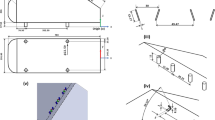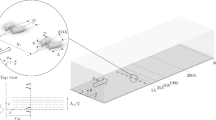Abstract
Engine processes require fundamental knowledge on specific fuel–air mixtures to reduce pollutant emissions, i.e., soot formation, \(\hbox {CO}_2\), and \(\hbox {NO}_{x}\) generation, and to improve engine efficiency. However, the in-cylinder flow field of combustion engines is characterized by time-dependent and highly three-dimensional large-scale flow structures and cycle-to-cycle variations (CCV). This means that high-speed volumetric velocity measurements are required to investigate three-dimensional large-scale flow structures and CCV inside the combustion chamber at high temporal resolution. Since such data are hardly available in the literature, a high-speed tomographic particle image velocimetry (HS-TPIV) setup is used to measure the velocity field in an internal combustion engine at an engine speed of 1500 rpm and at a temporal resolution of \(10\,^\circ\) crank angle in a maximum measurement volume of \(50\times 8\times 83\,\hbox {mm}^3\). To assess the quality and the validity of the high-speed volumetric measurements, the HS-TPIV results are validated using high-speed stereoscopic particle image velocimetry measurements in the engines tumble plane. To further verify the measurement quality, an extensive error estimate is conducted. Finally, the instantaneous, three-dimensional measurement results are used to analyze the impact of fluctuations due to turbulence and CCV on the flow field in several instantaneous engine cycles at several predefined crank angles. The investigation shows the three-dimensional extent of flow fluctuations inside combustion engines and qualitatively quantifies the effect of CCV in in-cylinder flow.
Graphic abstract





















Similar content being viewed by others
References
Aleiferis PG, Behringer MK, Malcolm JS (2017) Integral length scales and time scales of turbulence in an optical spark-ignition engine. Flow Turbul Combust 98(2):523–577. https://doi.org/10.1007/s10494-016-9775-9
Arcoumanis C, Hu Z, Vafidis C, Whitelaw JH (1990) Tumbling motion: a mechanism for turbulence enhancement in spark-ignition engines. SAE Trans 99(3):375–391
Baum E, Peterson B, Surmann C, Michaelis D, Böhm B, Dreizler A (2012) Tomographic PIV measurements in an IC engine. In: 16th international symposium on applications of laser techniques to fluid mechanics, Lisbon, Portugal
Baum E, Peterson B, Bhm B, Dreizler A (2013a) On the validation of LES applied to internal combustion engine flows: part 1: comprehensive experimental database. Flow Turbul Combust 92(1–2):269–297. https://doi.org/10.1007/s10494-013-9468-6
Baum E, Peterson B, Surmann C, Michaelis D, Bhm B, Dreizler A (2013b) Investigation of the 3D flow field in an IC engine using tomographic PIV. Proc Combust Inst 34(2):2903–2910. https://doi.org/10.1016/j.proci.2012.06.123
Benedict LH, Gould RD (1996) Towards better uncertainty estimates for turbulence statistics. Exp Fluids 22(2):129–136. https://doi.org/10.1007/s003480050030
Borée J, Miles PC (2014) In-cylinder flow. Encycl Automot Eng. https://doi.org/10.1002/9781118354179.auto119
Brassat A, Thewes M, Müther M, Pischinger S (2011) Massgeschneiderte kraftstoffe aus biomasse für ottomotoren. MTZ Motortechnische Zeitschrift 72(12):988–995. https://doi.org/10.1365/s35146-011-0212-2
Braun M, Palmer J, van Overbrggen T, Klaas M, Kneer R, Schrder W (2017) Influence of in-cylinder air flow on spray propagation. SAE Int J Engines 10(4):1398–1410. https://doi.org/10.4271/2017-01-9280
Braun M, Klaas M, Schrder W (2018) Influence of miller cycles on engine air flow. SAE Int J Engines. https://doi.org/10.4271/03-11-02-0011
Bücker I, Karhoff DC, Klaas M, Schröder W (2012) Stereoscopic multi-planar PIV measurements of in-cylinder tumbling flow. Exp Fluids 53(6):1993–2009. https://doi.org/10.1007/s00348-012-1402-5
Bücker I, Karhoff D, Dannemann J, Pielhop K, Klaas M, Schröder W (2013) Comparison of PIV measured flow structures in two four-valve piston engines. New Res Numer Exp Fluid Mech VIII 121:633–640. https://doi.org/10.1007/978-3-642-35680-3_75
Chen H, Xu M, Hung DL, Zhuang H (2014) Cycle-to-cycle variation analysis of early flame propagation in engine cylinder using proper orthogonal decomposition. Exp Therm Fluid Sci 58:48–55. https://doi.org/10.1016/j.expthermflusci.2014.06.017
Daniel R, Tian G, Xu H, Wyszynski ML, Wu X, Huang Z (2011) Effect of spark timing and load on a DISI engine fuelled with 2,5-dimethylfuran. Fuel 90(2):449–458. https://doi.org/10.1016/j.fuel.2010.10.008
Druault P, Guibert P, Alizon F (2005) Use of proper orthogonal decomposition for time interpolation from PIV data. Exp Fluids 39(6):1009–1023. https://doi.org/10.1007/s00348-005-0035-3
Elsinga GE, Scarano F, Wieneke B, van Oudheusden BW (2006) Tomographic particle image velocimetry. Exp Fluids 41(6):933–947. https://doi.org/10.1007/s00348-006-0212-z
Esfandiari RS (2017) Numerical methods for engineers and scientists using MATLAB®, 2nd edn. CRC, Boca Raton
Gadekar S, Singh AP, Agarwal AK (2016) Tomographic PIV evaluation of in-cylinder flow evolution and effect of engine speed. SAE Int 2016-01-0638. https://doi.org/10.4271/2016-01-0638
Gosman AD, Tsui YY, Vafidis C (1985) Flow in a model engine with a shrouded valve-a combined experimental and computational study. In: SAE technical paper series, SAE International, 10.4271/850498
Graftieaux L, Michard M, Grosjean N (2001) Combining PIV, POD and vortex identification algorithms for the study of unsteady turbulent swirling flows. Meas Sci Technol 12(9):1422. https://doi.org/10.1088/0957-0233/12/9/307
Heywood JB (1988) Internal combustion engine fundamentals. McGraw-Hill, New York
Hoppe F, Burke U, Thewes M, Heufer A, Kremer F, Pischinger S (2016) Tailor-Made Fuels from Biomass: Potentials of 2-butanone and 2-methylfuran in direct injection spark ignition engines. Fuel 167:106–117. https://doi.org/10.1016/j.fuel.2015.11.039
Janssen A, Mther M, Pischinger S, Kolbeck A, Lamping M (2009) Tailor-Made Fuels: The potential of oxygen content in fuels for advanced diesel combustion systems. SAE Technical paper 2009-01-2765. https://doi.org/10.4271/2009-01-2765
Jarvis S, Justham T, Clarke A, Garner CP, Hargrave GK, Halliwell NA (2006) Time resolved digital PIV measurements of flow field cyclic variation in an optical IC engine. J Phys Confer Ser 45:38–45. https://doi.org/10.1088/1742-6596/45/1/007
Kang KY, Oh SM, Lee JW, Lee KH, Bae CS (1997) The effects of tumble flow on lean burn characteristics in a four-valve SI engine. SAE Trans 106(3):981–989
Lumley JL (1999) Engines: an introduction. Cambridge University Press, Cambridge. https://doi.org/10.1017/CBO9781139175135. ISBN:9780521644891
Mahmood Z, Chen A, Yianneskis M, Ganti G (1996) On the structure of steady flow through dual-intake engine ports. Int J Numer Methods Fluids 23(10):1085–1109. https://doi.org/10.1002/(SICI)1097-0363(19961130)23:10%3C1085::AID-FLD468%3E3.0.CO;2-X
Michaelis D, Novara M, Scarano F, Wieneke B (2010) Comparison of volume reconstruction techniques at different particle densities. In: 15th international symposium on applications of laser techniques to fluid mechanics, Lisbon, Portugal
Novara M, Batenburg KJ, Scarano F (2010) Motion tracking-enhanced MART for tomographic PIV. Meas Sci Technol 21(3):035401. https://doi.org/10.1088/0957-0233/21/3/035401
Peterson B, Baum E, Ding CP, Michaelis D, Dreizler A, Bhm B (2017) Assessment and application of tomographic PIV for the spray-induced flow in an IC engine. Proc Combust Inst 36(3):3467–3475. https://doi.org/10.1016/j.proci.2016.06.114
Pope SB (2000) Turbulent flows. Cambridge University Press, Cambridge
Scarano F (2012) Tomographic PIV: principles and practice. Meas Sci Technol 24(1):012001. https://doi.org/10.1088/0957-0233/24/1/012001
Shafiee S, Topal E (2009) When will fossil fuel reserves be diminished? Energy Policy 37(1):181–189. https://doi.org/10.1016/j.enpol.2008.08.016
Singh AP, Gupta A, Agarwal AK (2015) Tomographic particle image velocimetry for flow analysis in a single cylinder optical engine. SAE Int J Mater Manuf. https://doi.org/10.4271/2015-01-0599
Singh BR, Singh O (2012) Global trends of fossil fuel reserves and climate change in the 21st century. InTech
Thewes M, Mther M, Pischinger S, Budde M, Brunn A, Sehr A, Adomeit P, Kankermayer J et al (2011) Analysis of the impact of 2-methylfuran on mixture formation and combustion in a direct-injection spark-ignition engine. Energy Fuels 25(12):5549–5561. https://doi.org/10.1021/ef201021a
Towers DP, Towers CE (2004) Cyclic variability measurements of in-cylinder engine flows using high-speed particle image velocimetry. Meas Sci Technol 15(9):1917–1925. https://doi.org/10.1088/0957-0233/15/9/032
van Overbrüggen T, Klaas M, Bahl B, Schröder W (2015) Tomographic particle-image velocimetry analysis of in-cylinder flows. SAE Int J Engines. https://doi.org/10.4271/2015-01-9042
Voisine M, Thomas L, Borée J, Rey P (2010) Spatio-temporal structure and cycle to cycle variations of an in-cylinder tumbling flow. Exp Fluids 50(5):1393–1407. https://doi.org/10.1007/s00348-010-0997-7
Zhang J, Tao B, Katz J (1997) Turbulent flow measurement in a square duct with hybrid holographic PIV. Exp Fluids 23(5):373–381. https://doi.org/10.1007/s003480050124
Acknowledgements
This work was performed as part of the Cluster of Excellence “Tailor-Made Fuels from Biomass”, which is funded by the Excellence Initiative of the German federal and state governments to promote science and research at German universities. Additional funding was provided by the Deutsche Forschungsgemeinschaft (DFG, German Research Foundation) under Germany’s Excellence Strategy Cluster of Excellence 2186 “The Fuel Science Center”—ID: 390919832. Furthermore, this research is part of the project “Analysis of cycle-to-cycle variations in IC engines using high-speed Tomographic Particle-Image Velocimetry” funded by the German Research Association (Deutsche Forschungsgemeinschaft, DFG).
Author information
Authors and Affiliations
Corresponding author
Additional information
Publisher's Note
Springer Nature remains neutral with regard to jurisdictional claims in published maps and institutional affiliations.
Parts of this manuscript have been published in the proceedings of the “19th International Symposium on the Application of Laser and Imaging Techniques to Fluid Mechanics” in Lissbon, Portugal in July 2018.
Rights and permissions
About this article
Cite this article
Braun, M., Schröder, W. & Klaas, M. High-speed tomographic PIV measurements in a DISI engine. Exp Fluids 60, 146 (2019). https://doi.org/10.1007/s00348-019-2792-4
Received:
Revised:
Accepted:
Published:
DOI: https://doi.org/10.1007/s00348-019-2792-4




